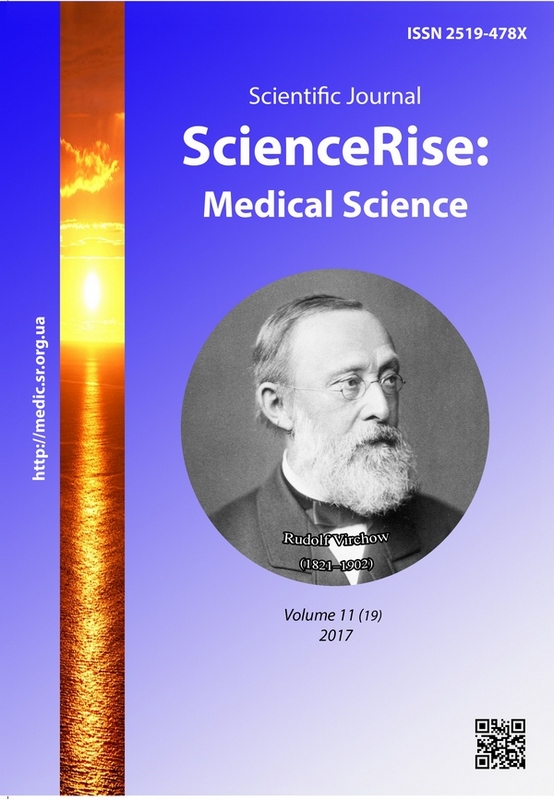Determination of signal calcineurin pathway biomarkers significance in early myocardial changes in children with bicuspid aortic valve
DOI:
https://doi.org/10.15587/2519-4798.2017.116752Keywords:
bicuspid aortic valve, children, myocardium hypertrophy, calcineurin, protein S100, interleukin-2, calciumAbstract
Aim of research: determination of the diagnostic value of serum concentration of biomarkers of calcineurin signal pathway (calcineurin, protein S100, interleukin-2) in children with the bicuspid aortic valve at absence of heart failure signs and influence of revealed changes on the early remodeling and hypertrophy of myocardium.
Materials and methods: 38 children with the bicuspid aortic valve (SAV), diagnosed by doppleroechocardiography, and 28 children of the control group underwent the measuring of concentrations of calcineurin, protein S100, interleukin-2 and general calcium by the immune-enzyme method with the further estimation of the influence of these changes on morphofunctional hearth parameters by the method of correlation analysis.
Results: children with SAV demonstrated the reliable thickening of the back wall of the left ventricle and interventricular septum at the correspondent increase of the blood velocity and pressure gradient on the aortic valve. Serum concentrations of calcineurin and calcium in children with SAV were reliably decreased, and protein S100 correspondingly increased comparing with the control group. At that the SAV group, as opposite to the control one, demonstrated reliable negative correlations between the calcineurin level and right ventricle sizes, protein S100 and left and right atria sizes interleukin-2 and left ventricle systolic size at the reliable positive correlation between levels of calcineurin and general calcium.
Conclusions: Children with SAV demonstrated the moderately expressed left ventricle myocardium hypertrophy, decrease of calcineurin serum concentrations that have a negative influence on the geometry of right heart parts and serum calcium level at the correspondent increase of protein S100. The revealed changes allowed to establish the predicative role of calcineurin in the development of early morphofunctional changes of myocardium in children with SAV
References
- Takano, H., Zou, Y., Akazawa, H., Nagai, T., Mizukami, M., Toko, H., & Komuro, I. (2003). Ca2+ – Dependent Signaling Pathways Through Calcineurin and Ca2+ Calmodulin – Dependent Protein Kinase in Development of Cardiac Hypertrophy. Progress in Experimental Cardiology, 85–94. doi: 10.1007/978-1-4615-0347-7_7
- Rich, R. R., Fleisher, T. A., Shearer, W. T., Chroeder, H., Frew, A. J., Weyand, C. M. (2012). Clinical Immunology E-Book: Principles and Practice. Elsevier Health Sciences, 1500.
- McPherson, R., Pincus, M. (2011). Henry's Clinical Diagnosis and Management by Laboratory Methods. Elsevier, 1568.
- Holton, M. (2009). PMCA as a Regulator of Calcium. University of Wolverhampton, 124.
- Wu, B., Baldwin, H. S., Zhou, B. (2013). Nfatc1 directs the endocardial progenitor cells to make heart valve primordium. Trends in Cardiovascular Medicine, 23 (8), 294–300. doi: 10.1016/j.tcm.2013.04.003
- Polovkova, O. G. (2013). Rol' genov signal'nogo puti kal'cinevrina v razvitii remodelirovaniya miokarda u bol'nyh ishemicheskoy bolezn'yu serdca. Tomsk, 23.
- Chapman, A. (Ed.) (2015). Bicuspid Aortic Valve: Diagnosis, Surgical Treatment and Complications. Nova Science Pub Inc, 75.
- Niwa, K., Kaemmerer, H. (Eds.) (2017). Aortopathy. Springer, 333. doi: 10.1007/978-4-431-56071-5
- Wolska, B. M. (2009). Calcineurin and cardiac function: is more or less better for the heart? AJP: Heart and Circulatory Physiology, 297 (5), H1576–H1577. doi: 10.1152/ajpheart.00833.2009
- Kehat, I., Molkentin, J. D. (2010). Molecular Pathways Underlying Cardiac Remodeling During Pathophysiological Stimulation. Circulation, 122 (25), 2727–2735. doi: 10.1161/circulationaha.110.942268
- Poirier, O., Nicaud, V., McDonagh, T., Dargie, H. J., Desnos, M., Dorent, R. et. al. (2003). Polymorphisms of genes of the cardiac calcineurin pathway and cardiac hypertrophy. European Journal of Human Genetics, 11 (9), 659–664. doi: 10.1038/sj.ejhg.5201023
- Linde, E. V., Ahmetov, I. I., Ordzhonikidze, Z. G., Astratenkova, I. V., Fedotova, A. G. (2009). Vliyanie polimorfizmov genov ASE, RRARA, PPARD i NFATC4 na kliniko-funkcional'nye harakteristiki sportivnogo serdca. Mezhdunarodnyy zhurnal intervencionnoy kardioangiologii, 17, 50–56.
- Wang, X., Wang, M. (2010). The S100 protein family and its application in cardiac diseases. World J. Emerg. Med., 1 (3), 165–168.
- Wang, D., Fang, J., Wang, R., Sun, D., Xia, K., Yin, W. et. al. (2016). Elevated serum ghrelin, tumor necrosis factor-α and interleukin-6 in congenital heart disease. Pediatrics International, 58 (4), 259–264. doi: 10.1111/ped.12773
- Madhok, A. B., Ojamaa, K., Haridas, V., Parnell, V. A., Pahwa, S., Chowdhury, D. (2006). Cytokine Response in Children Undergoing Surgery for Congenital Heart Disease. Pediatric Cardiology, 27 (4), 408–413. doi: 10.1007/s00246-006-0934-y
- Siu, S. C., Silversides, C. K. (2010). Bicuspid Aortic Valve Disease. Journal of the American College of Cardiology, 55 (25), 2789–2800. doi: 10.1016/j.jacc.2009.12.068
Downloads
Published
How to Cite
Issue
Section
License
Copyright (c) 2017 Andrey Kamenshchyk

This work is licensed under a Creative Commons Attribution 4.0 International License.
Our journal abides by the Creative Commons CC BY copyright rights and permissions for open access journals.
Authors, who are published in this journal, agree to the following conditions:
1. The authors reserve the right to authorship of the work and pass the first publication right of this work to the journal under the terms of a Creative Commons CC BY, which allows others to freely distribute the published research with the obligatory reference to the authors of the original work and the first publication of the work in this journal.
2. The authors have the right to conclude separate supplement agreements that relate to non-exclusive work distribution in the form in which it has been published by the journal (for example, to upload the work to the online storage of the journal or publish it as part of a monograph), provided that the reference to the first publication of the work in this journal is included.









